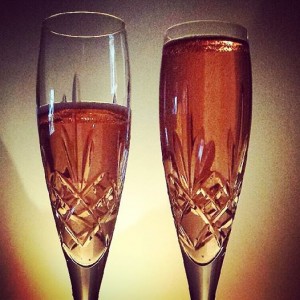image © Total Control
A friend is running a social media project, Total Control, as part of some university studies. The other day on both Instagram (where I first saw it) and Facebook she published the above picture of two flutes, annotated that the glass on the left contains 100mL of wine and one standard drink.
I called her out on this pretty quickly (not because I am a bad person, but because I am a pedant!). 100mL of wine is not (necessarily) one standard drink.
In fact, one standard drink in Australia is not (necessarily) one standard drink anywhere else. And … guess what? A standard drink has (almost certainly) nothing to do with how much you’re poured in a bar or restaurant.
Confused? I doubt you’re alone.
In fact, if we look at the Australian Government’s official guidelines on calculating standard drinks we are treated to the following …
“Volume of Container in Litres multiplied by the percentage of alcohol volume multiplied by 0.789, equals the number of standard drinks”.
0.789 is the specific gravity of ethyl alcohol and in Australia a ‘standard drink’ (or unit) is defined as 10g of ethyl alcohol.
So if you’re calculating the number of standard drinks in your schooner of beer (a schooner in South Australia is 285mL) and you happen to know the beer you’re drinking is 4.5% abv (you’re drinking a Coopers Pale, right?) then why … it’s just:
0.789 * .285 * 4.5
You can do that in your head, right? The answer is 1.01 standard drinks.
With beer, this is (relatively) easy because beer is usually served in standardised sizes.
However, wine is a different ball game altogether. Wine glass sizes are NOT standardised. Sure, many venues have glasses with pouring lines on them but unless you ask you won’t know what that volume is (and even sometimes once you do ask you’ll be none the wiser). So 100mL of a wine at 13.5% abv will indeed give you that one standard drink (well 1.07 …). But you’re more likely to have been poured in the region of 150mL (.15*.789*13.5 = 1.6) and if you’ve got a bottle of wine on the table and you’re pouring it yourself? You’ve got buckleys.
Once you’ve nailed your .789 times tables, you’re best off not travelling. While the UK has standardised servings for wine (125mL, 175mL, 250mL and multiples of 175mL thereafter) the UK unit of alcohol is 10mL.
And guess what – alcohol isn’t water – there’s no cosy one-to-one relationship between volume and mass. 10mL of water will indeed be 10g of water. 10mL of alcohol? 7.9 grams. And Australia’s 10g of alcohol comes in at 12.7mL.
But wait! There’s more!
Your bottle of wine will announce it’s 13.5% abv … but is it? Our wine labelling laws here in Australia allow a whopping 1.5% abv difference*. That’s not a tolerance of 1.5% but a whole actual 1.5 percentage points. Your 13.5% abv bottle of wine might actually be 15%!
And how does that affect the maths?
.1 * .789 * 15 = 1.2
But if it’s only 12% abv …
.1 * .789 * 12 = .95
I’m a great believer that there’s no point in complaining about things if you can’t posit some possible solutions. So, what to do?
Normally, I’d say the first thing to look at is education – but anyone who’s just read through the above is most likely reaching for a drink!
Things should be more simple.
Firstly, I believe that defining a standard drink by mass rather than volume is unnecessarily confusing. And not only do the concepts need to be easy to understand but the maths needs to be simpler too. Defining a standard drink as 10mL of alcohol kills both those birds with one stone. You have 100mL of a wine that’s 13.5% abv? Guess what – that’s 1.35 standard drinks.
The follow on from this is that serving sizes in bars need to be standardised.
Finally, I believe our labelling laws are letting us down. I’m happy to bet that most punters don’t realise there’s so much flexibility with alcohol labelling. I see no reason why the tolerance for table wine should be different to that for fortifieds or spirits and I see no reason why it can’t be a tighter and more properly defined tolerance (that is, plus or minus a percentage of what you are claiming – and that tolerance is flat, across the board). While I’m not au fait with the technologies used by the wine industry to measure alcohol concentration I’m sure we can do better (and, in fact, we do do better because many of our export markets have much tighter requirements).
And then we have to back this up with education.
Unfortunately, I can see that these ideas do start to place extra burden across almost all sectors of the industry. Whether or not that burden is justified, I don’t know.
Personally, I think the most critical part of any alcohol education campaign is the importance of alcohol free days (the dreaded AFD). This is something that is really easy for people to understand – no maths involved.
One AFD a week is good, and two is better.
* Food Standard 2.7.1, July 2014.
